Explore Muscat - Oman Travel, Asia
Muscat, the capital city of Oman, offers travelers a perfect blend of history, culture, and natural beauty. Nestled between the rugged Hajar Mountains and the sparkling Arabian Sea, this picturesque city captivates visitors with its pristine beaches, historic forts, and modern architecture. From wandering through vibrant souks filled with handcrafted goods to exploring ancient landmarks steeped in history, Muscat invites you to immerse yourself in the heart of Omani culture. Whether you’re an adventurer, a history enthusiast, or a foodie, Muscat has something special for every traveler.
Population: Approximately 1.7 million in 2024.
Economy: Muscat's economy thrives on oil and gas exports, tourism, and trade. As Oman's capital, it plays a key role in the nation’s financial sector, with growing investments in infrastructure and logistics.
Landmarks: Famous for the Sultan Qaboos Grand Mosque, Royal Opera House Muscat, and the Al Jalali and Al Mirani Forts.
Oman
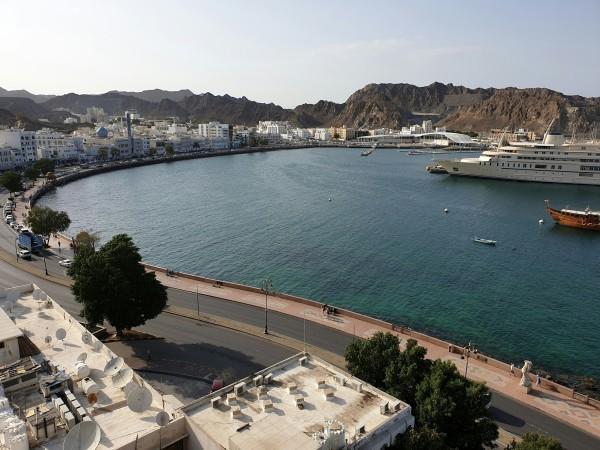
Overview of Muscat
History & Cultural Influence
For centuries, Muscat has been a vital trading hub, linking the East and West with its bustling ports. Evidence of Muscat’s significance can be found in its architecture, traditions, and landmarks. As you stroll through the city, you’ll notice the influence of various civilizations, including the Portuguese, Persians, and Ottomans, each leaving their mark on the city’s heritage. In terms of culture, Muscat remains rooted in Islamic traditions, yet it embraces modernity with open arms. It’s a city where the past seamlessly meets the present, and where every corner tells a story of resilience and progress.
Interaction with The Locals
Muscat, the capital of Oman, has a population of Omani citizens and expatriates, with Omanis making up the majority. The local population is known for their warm hospitality and deep respect for tradition, while the expat community brings a diverse range of cultures to the city. Omanis are proud of their heritage, with Islam playing a central role in daily life, yet they are welcoming to visitors and open to sharing their culture.
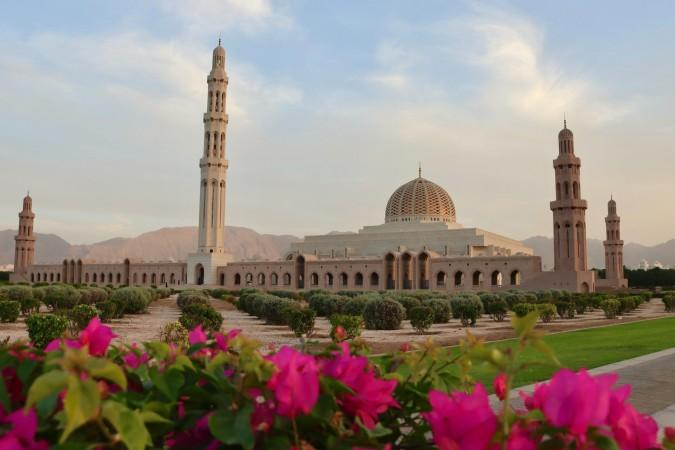
Sultan Qaboos Grand Mosque - © Hongbin
Top Attractions in Muscat
Sultan Qaboos Grand Mosque
The Sultan Qaboos Grand Mosque is one of the most iconic landmarks in Muscat and a masterpiece of Islamic architecture. With its magnificent marble walls, intricate mosaics, and the world’s second-largest chandelier, this mosque is a stunning sight to behold. Visitors can go around the mosque's calm prayer halls and view the world's second-largest Persian carpet. It’s open to non-Muslim visitors in the mornings, offering a peaceful atmosphere to appreciate Islamic art and culture.
Royal Opera House Muscat
The Royal Opera House Muscat is a cultural gem that hosts world-class performances, including opera, ballet, and traditional Omani music. This architectural marvel blends modern and traditional Omani styles, with its grand halls and intricate designs. Even if you're not attending a performance, the opera house is worth a visit for its beauty and the cultural significance it holds in the region.
Al Jalali and Al Mirani Forts
The Al Jalali and Al Mirani Forts are historic structures dating back to the sixteenth century that were built by the Portuguese. These forts originally played an important role in defending the city from invaders. Today, they provide spectacular panoramic views of Muscat and its shoreline. Exploring the forts allows visitors to step back in time and experience Oman’s military history firsthand.
Mutrah Souq
For a taste of traditional Omani life, head to Mutrah Souq, one of the oldest and most vibrant markets in the Arabian Peninsula. Here, you’ll find a treasure trove of goods, from fragrant spices and perfumes to intricate silver jewelry and handmade textiles. This bustling marketplace is an ideal spot for picking up souvenirs, while its lively energy and rich scents transport you to another era.
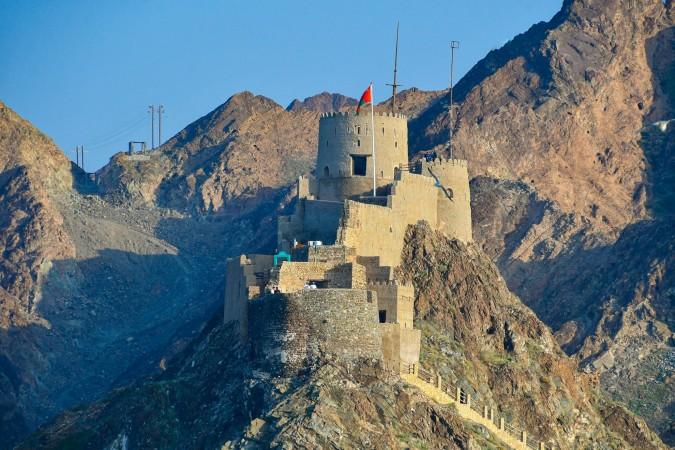
Mutrah Souq - © SnapSaga
Must-Try Dishes in Muscat
Muscat’s local cuisine is a reflection of Oman’s rich cultural heritage, offering a variety of traditional dishes that highlight the country's unique flavors. In addition to the iconic local dishes, there are several other specialties that visitors should try to fully appreciate Omani cuisine.
- Shuwa: A highlight of Omani cuisine, Shuwa is slow-cooked lamb that’s marinated in spices and wrapped in banana leaves before being cooked underground for up to 48 hours. The result is incredibly tender and flavorful meat, often served during special occasions like Eid.
- Majboos: Also known as Kabsa, Majboos is a fragrant rice dish cooked with a variety of spices such as saffron, cinnamon, and cardamom, typically accompanied by chicken, lamb, or fish. It’s a flavorful, filling meal and a staple in many Omani households.
- Mashuai: Mashuai is a traditional dish made of roasted kingfish served with rice and a tangy lemon sauce. This coastal favorite is known for its fresh, delicate flavors and is popular throughout Muscat’s seaside restaurants.
- Omani Halwa: A popular sweet treat, Omani Halwa is made from sugar, rosewater, ghee, and a blend of spices like saffron and cardamom. It has a sticky, jelly-like consistency and is often served with dates and coffee during social gatherings.
- Harees: Harees is a comforting dish made of wheat and meat, slow-cooked until it reaches a porridge-like consistency. It’s especially popular during Ramadan and other religious festivals, offering a warm and hearty meal that reflects the simplicity of traditional Omani cooking.
- Mishkak: A popular street food in Oman, Mishkak consists of skewers of marinated meat (typically beef, chicken, or lamb) grilled over hot coals. The marinade, made with spices, garlic, and vinegar, gives the meat a smoky, tangy flavor. It’s often served with flatbread and is a common sight at roadside stalls and local festivals.
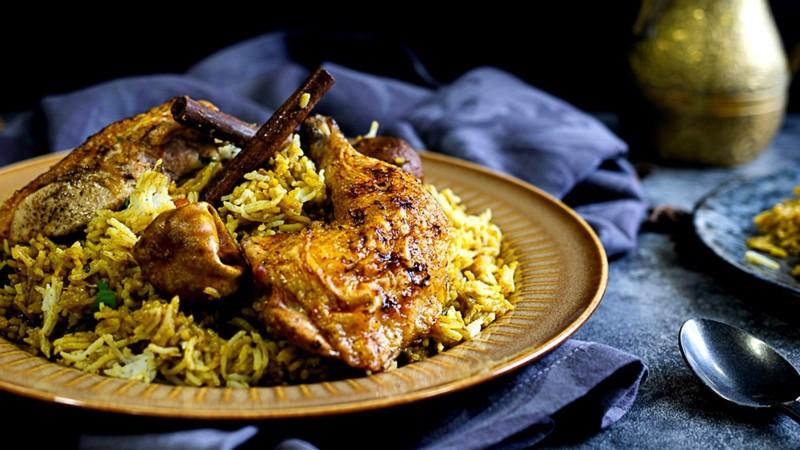
Majboos - © Chef Middle East At Home
Festivals & Local Celebrations
Muscat is home to several festivals and celebrations that showcase the country’s vibrant culture and traditions. These events are a great way to experience the local way of life and witness the sense of community that defines Oman.
Muscat Festival
Held annually in January and February, the Muscat Festival is a month-long celebration of Omani culture, arts, and traditions. It features cultural performances, traditional crafts, and local food stalls. Visitors can experience everything from folk dances to camel races and art exhibits, making it a must-attend event for those interested in Oman’s heritage.
Eid al-Fitr & Eid al-Adha
As a predominantly Muslim country, Oman celebrates both Eid al-Fitr and Eid al-Adha with great enthusiasm. These Islamic festivals are marked by prayer, feasts, and social gatherings. During these times, families come together to share meals, and visitors can witness the strong sense of community and generosity that permeates Omani culture.
Oman’s National Day
Celebrated on November 18th, Oman’s National Day commemorates the country’s independence and the reign of Sultan Qaboos bin Said. Parades, fireworks, and traditional performances take place throughout Muscat, creating a lively and patriotic atmosphere. It’s a great time to be in the city and experience the national pride that runs deep in Omani society.
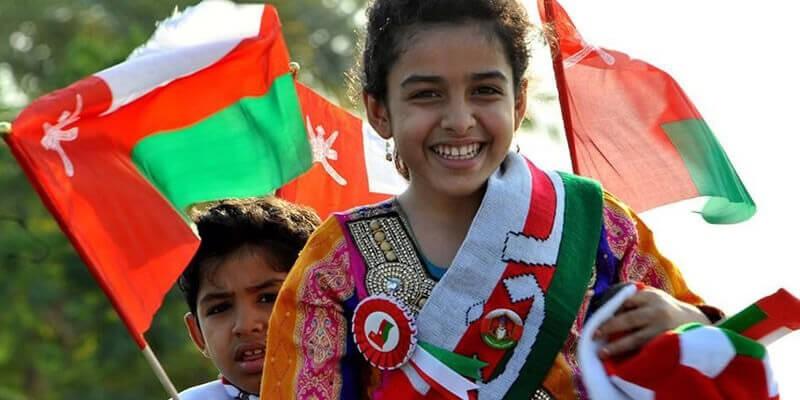
Oman’s National Day celebrations - © Edarabia
What to Do in Muscat
- Dolphin Watching in Muscat: Muscat’s coastline is home to some of the best snorkeling spots in the region. Places like Bandar Al Khayran and Daymaniyat Islands offer crystal-clear waters teeming with marine life. For those seeking adventure, dolphin-watching tours are popular in Muscat, where you can observe pods of dolphins swimming through the azure waters of the Arabian Sea.
- Desert Safari: For a taste of the Omani desert, head out on a desert safari where you’ll experience dune bashing, camel riding, and the serene beauty of the vast Omani desert. The nearby Wahiba Sands offers an unforgettable landscape with towering dunes and the chance to spend a night under the stars in a traditional Bedouin camp.
- Historical & Cultural Tours: History lovers can enjoy guided tours of Muscat’s ancient landmarks, including Bait Al Zubair Museum and Al Alam Palace. These tours offer in-depth insights into Omani heritage and the city’s pivotal role in regional history. Visiting local mosques and souqs allows you to experience Omani culture up close.
Shopping in Muscat
- Mutrah Souq: The Mutrah Souq is one of Muscat’s most famous traditional markets and a must-visit for anyone interested in buying authentic Omani goods. Here, you’ll find a vibrant collection of items such as spices, perfumes, silverware, textiles, and handcrafted jewelry.
- Muscat Grand Mall: For a more modern shopping experience, head to the Muscat Grand Mall, one of the city’s largest and most popular malls. It houses a mix of international brands, local boutiques, and a variety of dining options.
- Oman Avenues Mall: Another modern shopping destination, Oman Avenues Mall, offers an array of luxury and lifestyle stores, from fashion to electronics. It’s an excellent spot for high-end shopping with family-friendly amenities, including restaurants, a cinema, and entertainment options for kids.
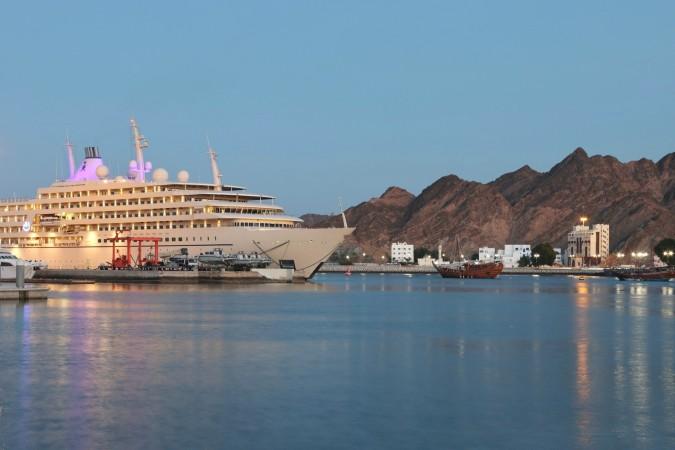
Experience Muscat Bay boat tours - © Hongbin
Weather in Muscat: Best Time to Visit
Muscat experiences a hot desert climate typical of the Arabian Peninsula, with long, scorching summers and mild winters. Understanding Muscat’s weather can help you plan the best time to visit the city, depending on your preferences for temperature and activities.
Summer in Muscat
Summers in Muscat are extremely hot, with temperatures often exceeding 40°C (104°F). The humidity, especially along the coast, can make it feel even hotter. Outdoor activities can be challenging during these months, so if you visit during this period, it’s best to stick to indoor attractions, such as museums and shopping malls, or spend time at luxury resorts where air conditioning is readily available.
Winter in Muscat
The winter months offer a much more pleasant climate, with temperatures ranging between 18°C and 30°C (64°F to 86°F). This is considered the best time to visit Muscat, as the cooler weather is ideal for outdoor activities like exploring historical sites, beach trips, and desert safaris. Rainfall is rare but can occur between December and March.
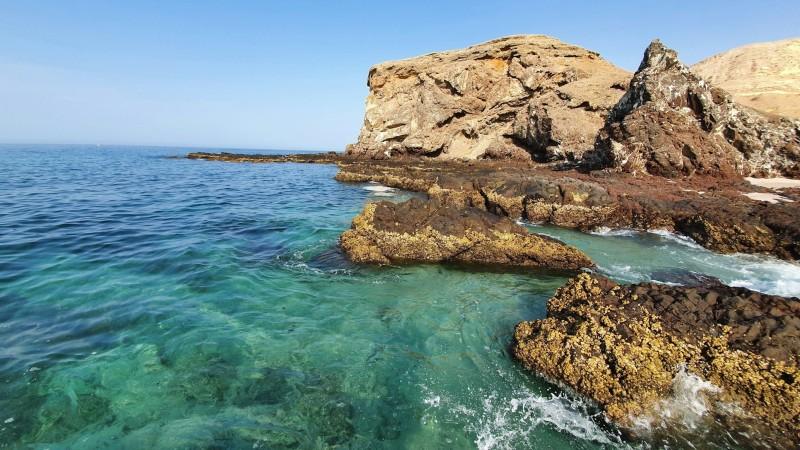
A clear day to explore Daymaniyat Islands - © Ghulam Mustafa
Essential Travel Information
Getting Around Muscat
- Public Transportation: Muscat’s public transport system is well-developed, with Mwasalat buses covering most of the city and surrounding areas. These buses are affordable, air-conditioned, and provide a convenient way to travel between major landmarks, malls, and residential areas. Tickets can be purchased from drivers or bus stations.
- Taxis: Taxis are a popular mode of transportation in Muscat, and they can be easily found at airports, hotels, and major tourist spots. Orange and white-colored taxis are traditional, and it’s important to negotiate the fare before starting your journey, as most taxis do not use meters.
- Car Rentals: Renting a car is a great way to explore Muscat and the surrounding areas at your own pace. Driving in Muscat is generally straightforward, with well-maintained roads and clear signage. However, be prepared for some traffic in busy areas during peak times.
ATM & Banking Services
Muscat offers a modern banking system with easy access to ATMs and currency exchange services throughout the city. ATMs can be found in key locations such as shopping malls, tourist spots, and the airport, and they typically accept international debit and credit cards. Currency exchange services are available at various locations, including exchange offices and hotels, though exchange rates may vary. Credit and debit cards are widely accepted at hotels, restaurants, and large stores, but it's advisable to carry some cash, especially when visiting local markets or smaller establishments.
Where to Stay in Muscat
- Luxury Hotels & Resorts: For travelers seeking an indulgent experience, Muscat is home to several luxury hotels and beachfront resorts. These properties offer stunning views, premium services, and exclusive amenities such as private beaches, world-class dining, and luxurious spas.
- Mid-Range Hotels: These hotels typically offer modern amenities, such as rooftop pools, fitness centers, and dining options, while being conveniently located near major attractions and city centers. Ideal for families or business travelers, these options provide a comfortable and affordable stay.
- Desert Camps: For those seeking a more authentic or adventurous experience, there are opportunities to stay in traditional desert camps. These unique accommodations allow travelers to experience Omani hospitality and culture up close, whether in a cozy, traditional setting or under the stars in a desert environment.
Des articles pour vous

Voyage à Kampong Cham - Cambodge, Asie
Kampong Cham est une charmante ville riveraine située le long du fleuve Mékong. Connue pour son importance historique et ses attractions culturelles, Kampong Cham offre un mélange d'architecture coloniale, de temples anciens et de paysages pittoresques. Kampong Cham est reliée au district voisin de Tbong Khmum par le pont Kizuna, le premier pont au Cambodge à traverser le fleuve Mékong, en faisant un carrefour de transport crucial pour la région.
Population : Estimation de 80 000 habitants (en 2024)
Économie : Bien que n'étant pas encore une destination touristique majeure, Kampong Cham propose des sites culturels et historiques, tels que le temple Wat Nokor et le pont en bambou de Koh Pen, ainsi que des attractions naturelles comme des forêts et des chutes d'eau. Le gouvernement se concentre sur le développement du tourisme pour améliorer l'économie locale.
Points d'intérêt : Wat Nokor Bachey, Phnom Han Chey, Phnom Pros et Phnom Srey, pont en bambou de Koh Pen, Wat Joy T'maw, Preah Theat Teuk Chha, piste d'atterrissage abandonnée de l'US.

Explorez Nha Trang - Voyage au centre du Vietnam, Asie
Nichée le long de la magnifique côte du Vietnam, Nha Trang se distingue comme une destination de premier choix pour les voyageurs. Cette ville côtière, réputée pour ses superbes plages et sa vie marine foisonnante, s'adresse à tous. Nha Trang vous accueille à bras ouverts, que vous recherchiez des aventures, de la culture ou de la détente au bord de la mer. Ce guide vous fera découvrir les points forts de cet endroit magnifique, facilitant ainsi la planification de votre voyage de manière fluide et excitante.
Population : Environ 423 000 habitants en 2019.
Économie : L'un des principaux centres touristiques du Vietnam et la plus grande économie de la province de Khanh Hoa.
Sites emblématiques : Célèbre pour les tours Cham de Po Nagar, la cathédrale de Nha Trang et l'île Hon Mun.

Voyage à Sihanoukville - Cambodge, Asie
Sihanoukville, une ville côtière du sud-ouest du Cambodge, est la capitale de la province de Preah Sihanouk. Située sur une péninsule le long du golfe de Thaïlande, la ville est bien reliée à Phnom Penh par des autoroutes principales et dispose d'un aéroport international.
La ville abrite le seul port en eau profonde du Cambodge, jouant un rôle crucial dans la logistique et le commerce du pays. Les plages magnifiques de Sihanoukville, telles qu'Ochheuteal et Serendipity, attirent aussi bien les touristes nationaux qu'internationaux. Le développement économique a prospéré ces dernières années, en particulier grâce à la création de la Zone économique spéciale de Sihanoukville (SSEZ) et aux investissements chinois dans les casinos, l'immobilier et les stations balnéaires. La ville offre également des attractions naturelles telles que le parc national de Ream et plusieurs îles voisines, en faisant une destination variée pour les voyageurs d'affaires et de loisirs.
Population : La population de Sihanoukville était d'environ 160 000 habitants en 2024.
Économie : Sihanoukville, une ville côtière en pleine croissance au Cambodge, se distingue par son mélange dynamique de développement économique et de tourisme. La Zone économique spéciale de Sihanoukville (SSEZ) est devenue un pôle industriel majeur, abritant plus de 180 entreprises et créant des milliers d'emplois. Avec le seul port en eau profonde du Cambodge, la ville joue un rôle clé dans le commerce et la logistique du pays. Bien qu'elle se soit transformée d'une petite ville balnéaire tranquille en un centre urbain animé, Sihanoukville reste célèbre pour ses plages immaculées, attirant des touristes tout au long de l'année. Les investissements chinois importants ont alimenté la croissance des hôtels, des casinos et de l'immobilier, faisant de la ville un centre d'opportunités économiques et d'hospitalité.
Monuments : Plage d'Otres, Plage d'Ochheuteal, Plage de l'Indépendance, Parc national de Ream, Chute d'eau de Kbal Chhay, Monument des Lions d'Or, Wat Leu.

Explorez Kharkhorin - Voyage en Mongolie, Asie
Bienvenue à Kharkhorin, un trésor historique niché au cœur de la Mongolie. Ancienne capitale vibrante de l'Empire Mongol sous le légendaire Gengis Khan, Kharkhorin se dresse comme un témoignage de la riche culture et de l'histoire de la Mongolie. Cette ville antique possède une combinaison unique d'importance historique et de paysages époustouflants, en faisant une destination incontournable pour un voyage de rêve en Mongolie. En mettant le pied à Kharkhorin, vous ferez un saut dans le temps, à une époque de grands palais, de routes commerciales prospères et d'échanges culturels sans pareils. Que vous soyez intrigué par les ruines anciennes, désireux d'explorer les traditions locales ou simplement en quête d'une immersion dans la beauté naturelle de la Mongolie, Kharkhorin a quelque chose à offrir à chacun.
Population : Environ 1 000 habitants en 2020.
Économie : L'une des attractions touristiques les plus importantes de la Mongolie et l'ancienne capitale de l'Empire Mongol.
Monuments : Célèbre pour les Ruines de Kharkhorin, le Monastère d'Erdene Zuu, et la Vallée d'Orkhon, un site du patrimoine mondial de l'UNESCO.

Explore Luang Prabang - Laos Travel, Asia
Luang Prabang, nestled in northern Laos at the meeting point of the Mekong river and Nam Khan river, is a city celebrated for its rich cultural heritage and stunning natural beauty. Recognized as a UNESCO World Heritage Site in 1995, it boasts a unique blend of traditional Lao and French architecture that has been carefully preserved. Whether you're wandering through its ancient temples, admiring the local architecture, or soaking in the natural beauty of waterfalls and rivers, Luang Prabang offers something for everyone.
Population: Approximately 470,000 in 2020.
Economy: Luang Prabang's economy thrives on tourism, with its UNESCO status drawing visitors to its temples, natural wonders, and cultural experiences. Local crafts, hospitality, and small businesses also play vital roles, supporting the town's sustainable growth. Local crafts, hospitality, and small businesses also play vital roles, supporting the town's sustainable growth.
Landmarks: Famous for the Wat Xieng Thong, Royal Palace Museum (also known as Haw Kham), and Mount Phousi (Phou Si Hill).Luang Prabang, nestled in northern Laos at the meeting point of the Mekong river and Nam Khan river, is a city celebrated for its rich cultural heritage and stunning natural beauty. Recognized as a UNESCO World Heritage Site in 1995, it boasts a unique blend of traditional Lao and French architecture that has been carefully preserved. Whether you're wandering through its ancient temples, admiring the local architecture, or soaking in the natural beauty of waterfalls and rivers, Luang Prabang offers something for everyone.
Population: Approximately 470,000 in 2020.
Economy: Luang Prabang's economy thrives on tourism, with its UNESCO status drawing visitors to its temples, natural wonders, and cultural experiences. Local crafts, hospitality, and small businesses also play vital roles, supporting the town's sustainable growth. Local crafts, hospitality, and small businesses also play vital roles, supporting the town's sustainable growth.
Landmarks: Famous for the Wat Xieng Thong, Royal Palace Museum (also known as Haw Kham), and Mount Phousi (Phou Si Hill).

Explore Vientiane - Laos Travel, Asia
Vientiane, the capital of Laos, offers a unique travel experience for those looking to explore a peaceful Southeast Asian city with a deep connection to its cultural roots. Unlike other bustling capitals, Vientiane boasts a serene and laid-back atmosphere, making it a perfect destination for travelers wanting to escape the chaos of more crowded cities. This charming city sits along the Mekong River, offering scenic views, rich history, and a vibrant yet tranquil way of life. As a gateway to exploring Laos, this capital invites you to slow down, immerse in its heritage, and enjoy the local flavors.
Population: Approximately 840,000 in 2023.
Economy: Vientiane's economy is growing steadily, driven by government services, trade, and tourism. Key sectors include agriculture, manufacturing, and construction. The city's strategic location along the Mekong River supports trade with neighboring Thailand and Vietnam.
Landmarks: Famous for the Pha That Luang, Patuxai, and the Buddha Park (or Wat Xieng Khuan).
